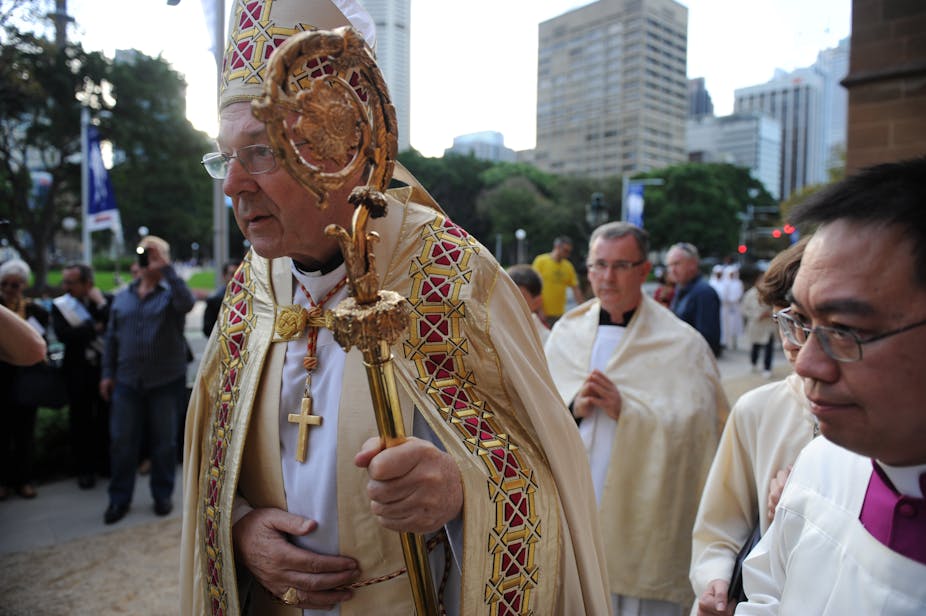Pope Francis I’s weekend announcement of a new council, the Group of Eight (G8), to advise him on Catholic Church governance and reforming the Church’s central administration (the Roman Curia) has been called the “most important step in the history of the church for the past 10 centuries” by Church historian Alberto Melloni.
The group includes Australian cardinal George Pell, who effectively represents Oceania in its concerns. These concerns could include our distance from decision-making in Rome, the appointment of bishops, and the understanding of our region. More general concerns for the G8 may include making the central administration more efficient, improving social communications, and recruiting more professional lay people, including women.
The decision to create the new advisory group seems a positive move to address the various scandals that have gripped the Vatican. Yet, the G8 has larger implications. It is formed in the context of a long-running debate about collegiality amongst the bishops and emerges from discussions that occurred before the recent conclave that elected Pope Francis.
“Collegiality” is a term used by Catholics to refer to the shared responsibility for the care of the Church that is held by the College of Bishops, with the pope (who is bishop of Rome) as head. Much debate over collegiality centres on the balance of power, responsibility and cooperation, particularly amongst the pope and the bishops.
While there have been some forums designed to promote collegiality since the Second Vatican Council, some bishops have been reported as feeling somewhat marginalised as power has been centralised. Nevertheless, for the bishops themselves, collegiality not only concerns power and identity, but more importantly, the mission of the Church: that the members of Church (especially the leadership) are working together - not at cross-purposes - to advance the cause of Christianity in the world.
Thus, the G8 indicates a papacy that is willing to come to terms with internal problems, but also to envision a form of leadership that is both global and local. Importantly, the representatives for the G8 are drawn from all continents. Most representatives currently hold or have held important leadership positions in their regions and some have a strong record of speaking out on internal church issues. The make-up of the G8 therefore reflects a focus on local church issues from the perspective of those on the ground.
The G8 has been described as a kind of “Cabinet” to the Pope. While these analogies can be problematic (as the group is only an advisory body), it does reflect a change in that regular consultation is going to be possible with a committee made-up of diocesan bishops, rather than curial officials.
While it is difficult to say how momentous this move will be, it is a decision that is in broad consistency with the Catholic tradition. Despite caricatures, the pope doesn’t really have absolute power – at least not in the sense it is often thought of – but is a steward of the Catholic tradition and is bound by its long history, including in his shared responsibility with the bishops.
Furthermore, as the Church continues to grow in many areas, its governance becomes increasingly complicated. The G8 represents an acknowledgement of the global reach of the Church. In particular, Pope Francis wants to support the priests and Catholics on the ground, such as those priests in Cuba who reportedly “travel around the countryside ministering to the poorest of the poor, travelling in a beat-up old car where they have to carry cans of gas”. How the voice of all the bishops, not to mention the priests and laity, will be managed through this structure is yet to be addressed.
However, the Vatican has made it clear that the G8 has not been established to interfere with the Curia’s duties of daily administration, but to provide a forum for the Pope to listen “attentively” to the cardinals. This move seems to represent a continuation of Pope Francis’ leadership style: to consult widely and directly, and then to make decisions himself (rather than delegating decisions).

The voice of the G8, then, can give support to Pope Francis in his moves to change the Church. In saying this, however, one must be careful of two mistakes: of how to understand “change”, and of making the Curia into the “bad guy” and the cause of all of the Church’s problems.
On the latter point, Pope Francis is being careful not to scapegoat the Curia. There are many good, competent and faithful people in the Curia. The Curia is a symptom, as well as a cause, of a larger problem in the Church that concerns its holiness and mission: are its members willing to give up all, even their ambitions, rivalries and pretentions at protecting the Church, in service to God’s will of love? This is a question that Pope Francis is now posing in his emphasis on “being poor”.
In asking this, a fundamental change in Catholics is being sought, not only structural change. Interestingly, with the Pope’s current emphasis on humble service, there are already reports in Italy of people returning to Confession in increased numbers.
This is why the people chosen for the G8, as well as the Pope’s own disposition, are important: they seem willing to collaborate with and listen to each other, to serve following Jesus’ own example. As important as open and effective structures are, they can only be enabled (or distorted) by the personalities, relationships and virtues of those involved.
In consistency with his predecessor Pope Benedict XVI’s teaching, Pope Francis wants Christians to return to their roots – to the humble poverty of the God who became human in Jesus and loved until death – to give impetus to the Church’s vision of a “new evangelisation”.

